
Product Demonstrations: Your Secret Weapon to Convincing Leads to Buy
Close more sales by using product demonstrations in your sales process. This article will teach you how to produce, present, and optimize demos that sell.
Product demonstrations are your one-way ticket to convincing leads to buy from you. They exist in the middle of your sales funnel in the intent stage, a critical step between awareness and purchase.
You must master the demonstration and communicate how your solution helps your customers manage questions and concerns related to your products, bolster their interest in your product and solidify their decision to buy from you. Without this skill, you’re losing out on leads and (worst of all) sales.
In this article, we’ll review:
- What product demonstrations are and why you should use them
- Common questions about product demonstrations
- The types of product demonstrations
- How successful SaaS and ecommerce companies use product demonstrations in their sales strategy
What is a product demonstration?
A product demo is a sales presentation to prospective customers on your product’s core functionality in hopes of closing a sale. Product demonstration occurs in the middle of the sales funnel in the consideration stage after qualifying a lead. Once you determine where your leads are in the funnel, you can set up a product demonstration.
What are sales demos, and are they the same as product demos?
Product demonstrations are also called sales demonstrations, sales demos, SaaS demos, or simply “demos.” Hubspot differentiates between product and sales demonstrations, saying that sales demos provide demonstrations to prospects, whereas product demos provide demonstrations to current customers.
However, thought leaders in the SaaS industry like Jacco van der Kooji consider them to be the same. In this article, we don’t differentiate between the two terms.
What are the different types of product demonstrations?
Product demonstrations can be live or recorded, delivered in person or through a digital medium, and given to one lead or to many at once. Several product demonstration methods convince your prospects to buy from you that you could be using today. They are:
- Product demonstration videos. These illustrate how your product functions and to help prospective and existing customers obtain relevant information to make a purchase decision.
- Store demonstrations. These demonstrations allow brands to showcase and promote products in-person to encourage immediate sales.
- Trade show product demonstrations. Just like in-store product demos, these allow brands to demonstrate products in real-time and allow sales reps to connect with prospective customers directly.
Why is product demonstration important?
Product demonstration is your chance to show potential customers why your product solves their problems.
Here are several additional product demonstration benefits:
Speeding up the purchasing process
Signing up for free trials or calling your sales team takes time and time is of the essence when persuading your leads to buy from you. Three-quarters of leads complete a sale within an hour of visiting your website, so you need to demonstrate the value of your product fast.
Product demonstrations are no-commitment, no sign-up solutions that save time for your leads. In just a few minutes, they can see how your product can solve their specific problem, and that’s worth a lot more than another sales pitch.
Allaying customer fears
According to Gerald Zaltman, a Harvard Business School professor, humans make 95% of their purchasing decisions subconsciously, meaning you must achieve a positive experience with your prospect. One way to do that is by talking directly to their pain points.
When giving live product demonstrations, leads have the opportunity to ask questions and offer product-related concerns.
They provide a rare opportunity to address your prospect’s main problems and offer potential customers a chance to see the product in action and experience how it works. This can be the deciding factor in whether or not they make a purchase.
Giving customers a sense of buying power
Customers don’t want to be forced into a sale; they want to be inspired into a purchase. Product demonstrations put the decision-making in the hands of the customer.
When customers see a product in action, they can imagine themselves using it, becoming the one in control of the product. Vividly imagining how your future would be better after purchasing the product can be a persuasive sales technique, which is why the test drive is the foundation of car salesmanship.
Enabling your sales team
Your best weapon for successful product demonstrations is: your salespeople. Your salespeople are highly-skilled professionals who know how to use the product to its best advantage and as a result, know how to sell it. A product demonstration is an excellent way for your sales team to seal the deal with prospective clients.
What should a product demonstration include?
A product demonstration must give prospects a clear idea of what the product does and how to use it.
To this end, your demo should be well-organized and concise, covering the most important points in only a few minutes.
The demo must be visually engaging, with clear imagery and an appealing design. But, of course, aesthetics and presentation are only part of the equation–the product itself must be compelling and offer value to potential customers.
Enjoying this article?
Subscribe to our newsletter, Good Question, to get insights like this sent straight to your inbox every week.
What are the steps involved in a product demonstration?
There are several steps involved in creating a compelling product demonstration.
Choose the right format for your audience
Product demonstrations done right are a powerful marketing tool; done wrong and you lose out on potential sales. The first consideration is choosing the correct format.
Will you demonstrate in-person, through a video, or live stream? Each option has its own advantages and disadvantages.
In-person demonstrations allow you to build rapport with potential customers and answer their questions directly. However, they can be logistically challenging to coordinate unless you have your own storefront.
Video demonstrations can be watched easily by a wider audience but lack the personal touch of an in-person demonstration.
Live streams offer the best of both worlds, allowing you to interact directly with viewers while reaching a large audience.
Ultimately, the best format depends on your specific product and goals. You can ensure a successful product demonstration by taking the time to choose a suitable format.
Plan ahead
Without preparation, your meeting will fall flat. You must tailor your demo to the audience you’re addressing, which means understanding their company, values, challenges, goals, and any additional helpful information. Identify at least 2-3 value propositions for your prospect.
Research who you’re meeting with, what role they have in the company, and cater your demonstration to how your solution addresses their needs and helps them meet their goals.
Establish a schedule
No one wants to go into a meeting without knowing what to expect, so don’t do this to your prospect. Instead, send all demo participants the presentation agenda in advance through email.
If you’re giving a live stream or in-person presentation, create social media posts in the week leading up to rev up your audience.
Include the demonstration’s run time as well as an outline of the meeting. This way, you won’t waste your prospect’s time or yours.
Allot time for questions
After you present your demonstration, allow time for questions. This way you can address any questions or concerns your prospects have. Then, ask your prospects questions about their goals, and current problems, and follow this up with ways your product’s features can help your prospect meet these goals and solve problems.
Questions might look like:
- “What is the top challenge you’re facing with your current solution provider?”
- “Your goals are A, B, C, has your current solution helped you attain these goals?”
Then, you can take the answers to these questions and follow them up by describing how your product’s value proposition solves their problems and helps them achieve their primary goal.
For example, you can say, “You mentioned A, B, C, are your goals. Here’s how our product helps you meet these and how you can achieve X result.”
Then, provide the prospect with further explanation for why the offered functionality is valuable.
Clarify the next steps
Once you finish your demonstration, ensure you have your prospect’s contact information, preferably email so that you can follow up in the next few days.
Send an email with details about what you discussed in your demo and remind your prospect of the unique value proposition your product provides for them.
You’ll move your prospect further down the sales funnel if all goes well. Integrate product demonstrations into your strategy to help increase conversions.
What are the qualities of great product demos?
Good product demos take your potential customers on a journey.
- First, you introduce the product.
- Then, you inform your prospects of its value proposition.
- Last, you persuade your prospects to act.
However, all three are pointless if you don’t convince your prospect that your product can solve their problems.
5 Stealable SaaS, B2B, and Ecommerce Examples of Effective Product Demonstrations
With the product demonstration basics down, we’ll examine compelling product demonstrations from different brands.
Once you see the principles of effective product demonstrations in action, you’ll be ready to prepare your own.
- The Interactive Product Demonstration: cPanel, a B2B company
cPanel is a web hosting control panel software providing website management and automation tools. Their demo is a classic example of a practical product demonstration. Here’s why:
- There’s no sign-up required to try it out. Prospects can interact with the demo immediately.
- What you see is what you get: the demo is exactly what a paid user’s control panel would like.
- Prospects can play around with the demo, testing out email forwarding, adding files to the public_html folder, and more.
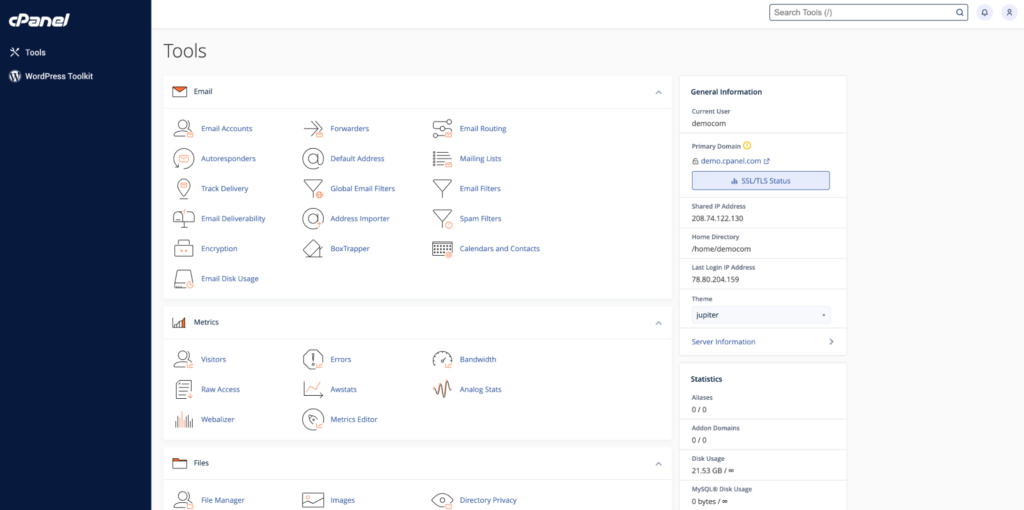
cPanel provides a real-time, fully immersive customer experience without any gimmicks or marketing.
This works because it puts your product directly in the hands of the consumer, allowing them to imagine themselves using the product as if it were their own installation. There’s no guesswork for the prospect. All of their answers lie in the demonstration.
- The Product Tour CTA: Marketo, a SaaS company
As soon as you land on Marketo’s landing page, you’re greeted with a CTA button for their interactive product tour.
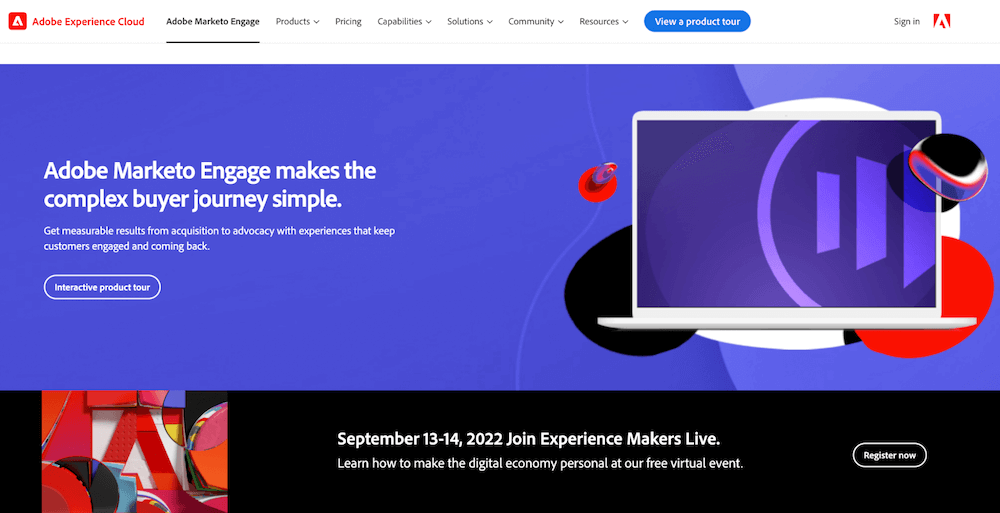
This CTA does two things:
- It takes the user directly to the product video demonstration.
- Once users land on the page, it immediately asks for their contact information.
This clever exchange gives both Marketo and the prospect what they want: Marketo can collect the lead’s contact information to follow up, and the prospect can view the product tour video.
Although it isn’t the only strategy, it is one of the best strategies since collecting lead data presents logistical challenges if you don’t have a plan in place. Put your CTA too low, and your customers may leave your site before they see it; leave your CTA out entirely, and you risk never gathering any lead information.
Once a lead types in their contact info, they land on the product video demonstration page:
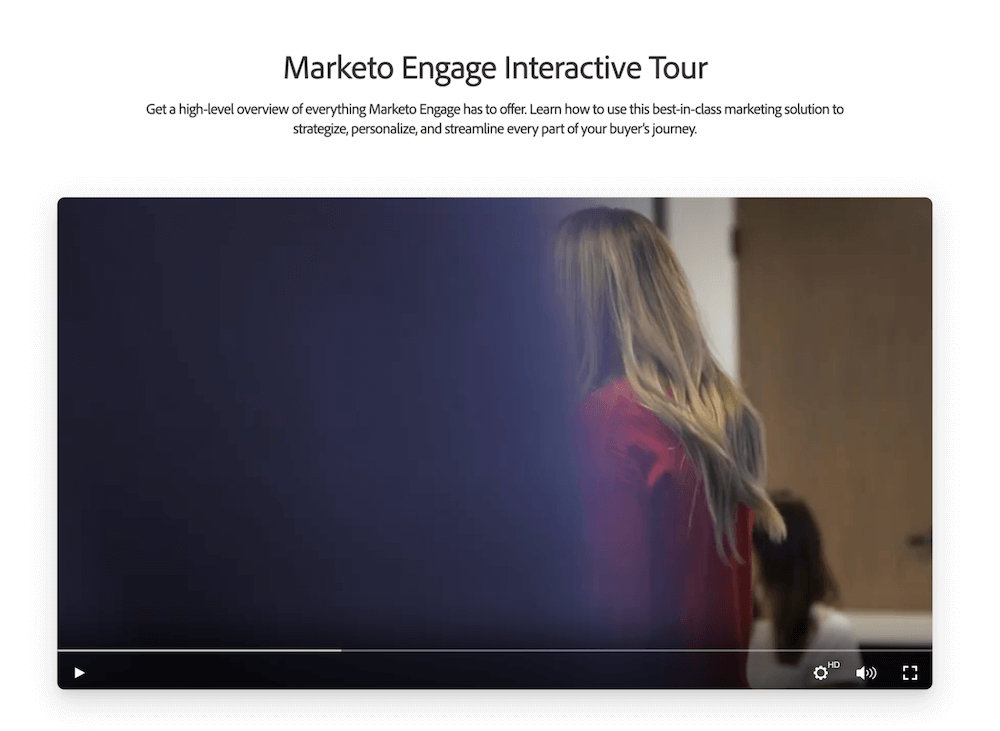
Marketo’s video walks users through common problems marketers face, use-cases, and its best features. Once viewers finish this quick three-minute video, users can scroll down to view additional use cases.
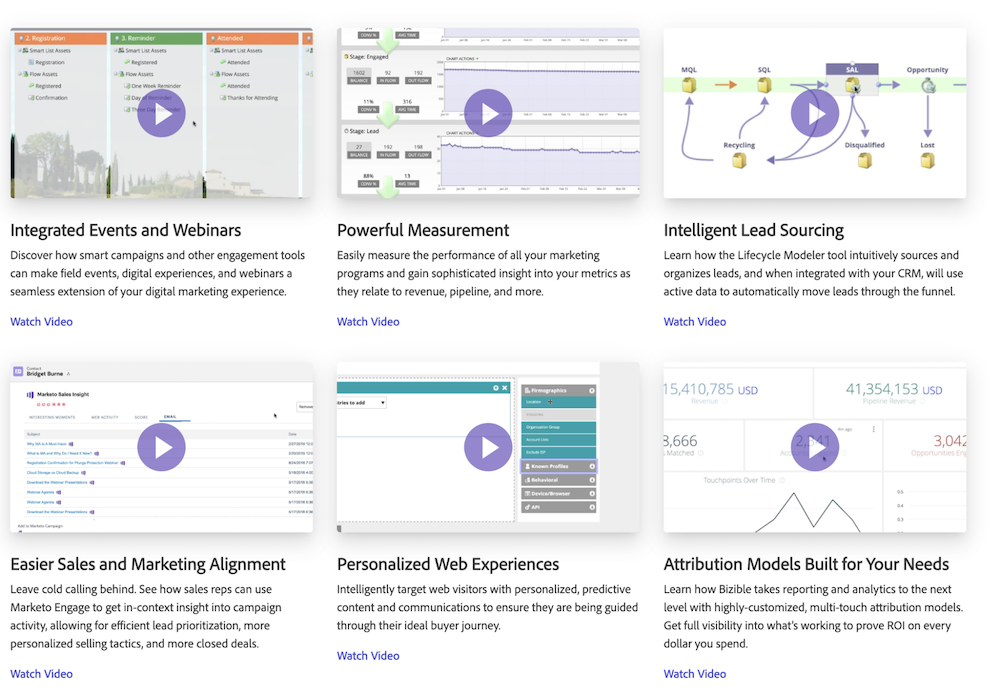
This allows potential customers to choose the video most relevant to their use case to see the product in action.
- The Demo Webinar: LeadDyno, a SaaS company
LeadDyno is a leading affiliate software program allowing users to manage and track their affiliate marketing efforts. On their demo page, LeadDyno offers prospects an option.
- They can join a live webinar.
- They can view three different videos showcasing LeadDyno’s features: a high-level overview, the affiliate dashboard, and the affiliate website.
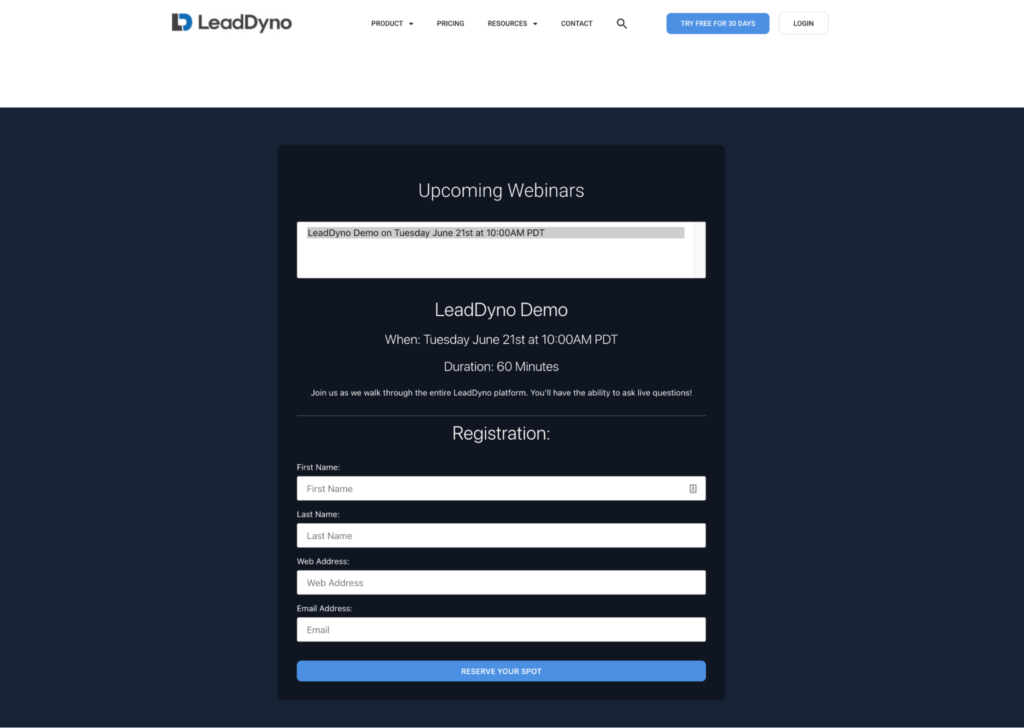
This is great because users can choose the demonstration method they prefer.
If users opt for the live webinar, they have the chance to ask questions about how LeadDyno’s software can solve their problems. And you have the chance to answer any questions your prospect may have. Offering a live webinar is a perfect chance to get to know your customers and build trust, a leading purchasing factor for customers.
Users who opt for the video walkthrough get a quick overview of how the product works (and if they still have questions, they have the option to sign up for a live webinar).
In addition, webinars provide an opportunity to showcase your product or service and drive more interest from potential customers.
4. The Detailed Product Demonstration Video: Patagonia, an ecommerce company
Patagonia is a leader in sustainable outerwear. They use product demonstrations in two ways.
The first way is through imagery. On their product pages, they show models of varying heights and sizes so customers can compare sizes and visualize themselves in the clothes.
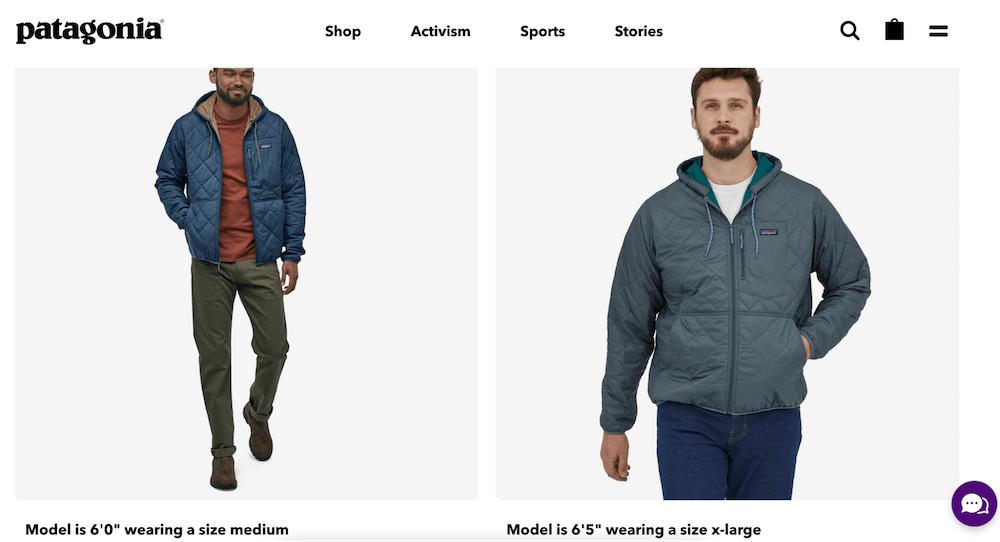
Not every man who orders this jacket will be 6’0” and wear a size medium, so they cover their bases by comparing it to another model wearing a larger size than the first.
Then, they include a video of another model wearing the jacket and turning around to give customers a 360 view of what the jacket looks like when worn. This way, customers don’t need to use their imagination. The jacket is right before their eyes so they can see what it will look like when they wear it.
5. The Traditional Product Video Demonstration: Solo Stove, an ecommerce company
Solo Stove sells stainless steel wood-burning stoves for campers.
This is a quintessential example of a product demonstration video. It has all of the qualities of an effective demonstration:
- It gives prospects a clear idea of what the product does and how to use it: while explaining Solo Stove’s main features, they show scenes of different people in their target demographic (campers) using the product.
- It’s well-organized and concise: In only 2 minutes, it explains what Solo Stove is and what it does as well as who uses it.
- They show videos of actual customers using them as social proof to build trust.
- They introduce a problem and follow it up with a solution: spending time with our loved ones is becoming more difficult so here’s how Solo Stove solves this problem.
They also use a lifestyle showcase technique where customers visualize themselves in the video, with their loved ones, using the product. They’re saying Solo Stove isn’t only a product, it’s a lifestyle and if you use our product, you can have this lifestyle too.
You can use this technique with your products, showcasing your products in a demonstration video as a part of the natural environment. For example, if you’re a makeup company, you can create a video showing various individuals wearing your makeup in different environments. Or if you’re a clothing brand, show individuals in different situations wearing your clothes.
Show customers what it’s like to experience your product so they can’t imagine a life without it.
Winning with product demos
Product demonstrations are an effective sales tool, moving leads through your sales funnel and closer to a purchase. If you can master the demonstration and communicate how your solution solves your lead’s problems, you will likely close the sale.
If you enjoyed this article, please subscribe to our newsletter!
Enjoying this article?
Subscribe to our newsletter, Good Question, to get insights like this sent straight to your inbox every week.

About the Author
James Sowers
James Sowers is the former Director of The Good Ventures. He has more than a decade of experience helping software and ecommerce companies accelerate their growth and improve their customer experience.